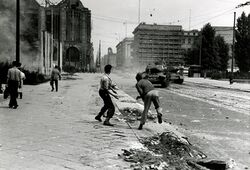May Action
| May Action Maiaktion |
|||||||
|---|---|---|---|---|---|---|---|
 Protestors throwing stones at a passing Kriegstruppen tank. |
|||||||
|
|||||||
| Belligerents | |||||||
| Commanders and leaders | |||||||
| Units involved | |||||||
| Unorganized Protestors | |||||||
| Casualties and losses | |||||||
| 2 police officers injured | 4 protesters dead, 15 wounded | ||||||
(WIP) The May Action (Saxon: Maiaktion) was the suppression of socialist protests, led by the Sozialistische Arbeiterbund (Socialist Workers Federation). After protestors pelted police officers with bricks and stones, the army and the Staatsschutzbehörde were controversially called in to end the protests. By nightfall, police had arrested hundreds of protestors and cataloged four dead.
Background
Even before the foundation of the UPC, trade unions and socialist movements had dominated the political landscape of Southeastern Cibola. In 1725 AN, several socialist organizations convened in the town of Geheim am Saida and proclaimed the creation of the united Sozialistische Arbeiterbund. Initially tolerated by the government in Weisenburg, this changed when the organization began calling for strikes and protests in Bülow and Altdorf which effectively halted the shipbuilding industry in the area for over a week.
In early 1726 AN, Erich Bosch (the Weisenburg district leader of the SAB) called for workers to walk about of their jobs and march to the seat of the Imperial Senate at the Altes Rathaus in a so-called "Arbieteraktion". At around 10:00 AM on the day of the action, workers around the city left their jobs in factories and assembled in the city square before marching to the Altes Rathaus.
The May Action
Initial Clashes
As local police spotted the mass of protestors marching towards the parliament building, officers began to form a barricade on the intersection of Georgstaße and Lehrstraße. When the protestors eventually reached the barricade, they began verbally berating and harassing the officers stationed there. According to police reports and witness testimonies of those at the intersection, several protestors began throwing stones, bricks, and other objects at the officers. With all of this stress on these officers, it was inevitable someone would lose their temper and shoot.
It is unclear if the police or a protestor shot first, but before many had the chance to recognize what had happened a full on gunfight was breaking out at the intersection. Two officers, Fritz Jürgens and Felix Bernauer, were wounded by .22 mm rounds. This moment is often seen as the time the protests became a riot. As the situation grew evermore violent, an officer (it is not clear whom) telephoned Weisenburg Police HQ of the dire situation. As the situation devolved further, more and more police with riot gear and shotguns were sent into the city center in order to quell the riots. With the situation clearly out of the control of the police the Lord-Mayor (Oberbürgermeister), one Erich Heidermann, placed a call to the headquarters of the 1st Infantry Division of the Weisenburger Kriegstruppen.
Army Involvement
Within the hour, armed soldiers poured into the Mitte district of the city and began to assist the police in arresting rioters. Several soldiers were spotted by witnesses beating protestors with swagger sticks and batons. With many of the rioters lacking firearms, soldiers were pelted with any heavy objects such as bricks, backpacks, and even their picket signs. These actions would eventually lead to the first deaths of rioters when 21 year old Josef Bümheffner was shot in the chest by a soldier.
Not satisfied with the slow progress of the quelling of the riot, 1st Division Headquarters authorized the deployment of 4 tanks into the area. These tanks did not have any shells in them, instead a gunner would man the machine gun on the top of the tank. The rioters would, as Generalmajor von Gerßalda would go on to state, stupidly begin to throw objects at these tanks. In retaliation, the gunners would mow down three protestors. Artur Teicher, Andreas Feilhaber, and Konstantin Schöner would die of their wounds received from being shot by tank-mounted machine guns.
End of the Riots
By 15:00, most of the rioters had fled the city center and returned to their homes. However, the Staatsschutzbehörde (the UPCs internal security organization) began the hunt for anyone involved in the protests. This operation was delegated to Chefinspekteur Fritz Weishaupt, the head of the SsB in the Weisenburg metropolitan area. His staff soon began combing several of the SsB's databases in search of suspecting socialists that could have taken part in the protests. He also ordered agents to gather testimonies of every officer and soldier that was sent to quell the protestors.
This aggressive hunt for suspected rioters led to hundreds of arrests of suspected socialists, trade unionists, and other left-wing dissidents. Many arrested were apprehended based on mere suspicion rather than any concrete evidence of their involvement. Due to the hasty nature of these arrests many did not have charges brought against them.
The SsB's greatest hit was the arrest of Erich Bosch himself, who was found hiding in a rented apartment in Schweikersstadt. Brought in front of the Imperial Court of Weisenburg on counts of Sedition and Incitement of a Riot, he was found guilty and given a 25-year jail sentence.
Aftermath
After the immediate aftermath of the riots began to settle, a official inquiry was launch to determine the disorganized response of local armed enforcement. The inquiry adjourned after only 2 weeks, sighting the lack of armed firepower and support for police forces as the reason of the escalation of violence.
The May Action led to the general distaste for labor organizations throughout the United Principalities. The leaders of many prominent worker's rights activists were arrested for "questioning" by the SsB. This paranoia of SsB surveillance led to many labor organizations being driven underground and began meeting in secret in the back of taverns, beer halls, and university dormitories. Many individuals and organizations soon grew evermore radical and revolutionary than they had been before the riots.